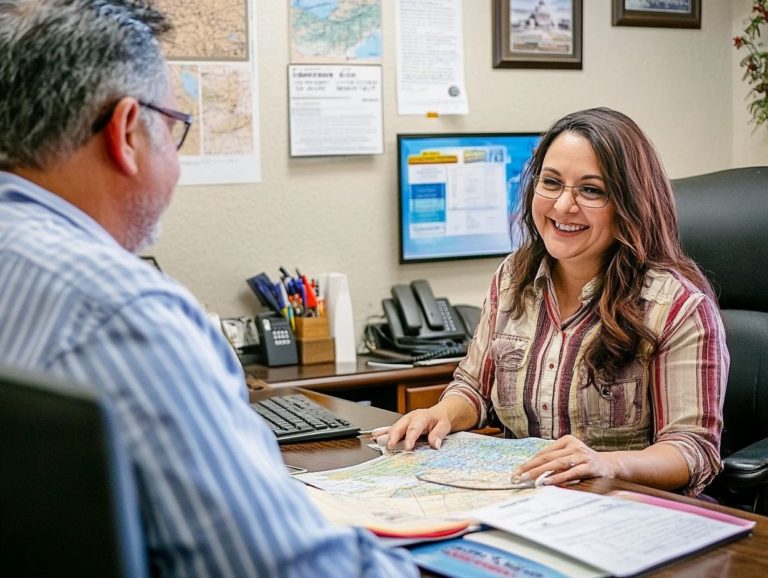6 Questions to Ask Your Agent About High-Risk Insurance
Navigating the world of insurance can feel overwhelming, especially when it comes to high-risk coverage. If you ve found yourself classified as more risky due to factors like your driving record, health history, or the nature of your business, understanding high-risk insurance is essential. This can save you money now and protect you later.
Let s dive in and equip you with the knowledge you need! This article delves into fundamental questions, shedding light on what high-risk insurance truly entails and how it stands apart from standard policies. You ll also discover strategies to potentially lower your premiums, which is the amount you pay for your insurance policy, and the crucial steps in the application process.
Contents
- Key Takeaways:
- 1. What Is Considered High-Risk Insurance?
- 2. What Factors Determine If I Need High-Risk Insurance?
- 3. How Does High-Risk Insurance Differ from Standard Insurance?
- 4. Will My Premiums Be Higher with High-Risk Insurance?
- 5. What Types of Coverage Are Included in High-Risk Insurance?
- 6. How Can I Lower My Risk and Potentially Lower My Premiums?
- 7. What Are the Top High-Risk Insurance Providers?
- Frequently Asked Questions
- What is considered high-risk insurance?
- What types of insurance fall under the high-risk category?
- How can I lower my premiums for high-risk insurance?
- What factors determine my risk level for insurance?
- Can I still get high-risk insurance if I have been denied coverage in the past?
- What should I do if I no longer need high-risk insurance?
Key Takeaways:

- High-risk insurance covers those deemed risky to insure.
- Factors like past claims, occupation, and driving record can determine if you need it.
- High-risk insurance typically offers less coverage and higher premiums compared to standard insurance.
1. What Is Considered High-Risk Insurance?
High-risk insurance refers to specialized insurance policies tailored for individuals or entities considered to pose a more risky profile to insurers. This classification often stems from elements like poor driving records, previous claims, or engagement in specific high-risk activities.
You may be categorized as high-risk if you seek car insurance after experiencing multiple accidents, raising red flags for insurers. If you own a home in an area prone to natural disasters like floods or wildfires, you might need specialized policies for adequate protection.
These classifications assist insurers in managing their overall risk and significantly impact the premiums you ll face. Therefore, choosing the right coverage is crucial when you’re in a high-risk category, as it can drastically influence your financial stability and peace of mind.
2. What Factors Determine If I Need High-Risk Insurance?
Several factors will influence whether you might need high-risk insurance, including your driving history, claims history, existing health conditions, and the nature of the assets you wish to insure. Each of these elements plays a crucial role in determining your coverage needs and the premiums associated with them.
For instance, if you are a younger driver or live in an area notorious for accidents, your auto insurance premiums may be notably higher due to perceived risk. Similarly, if you choose to drive a high-performance vehicle, expect those insurance costs to rise significantly.
Changes in your health status, such as receiving a diagnosis for a chronic condition (a long-term health issue), can dramatically shift your life insurance needs and lead you to seek out specialized policies. Various circumstances, from your geographic location to the type of coverage you desire, can result in different levels of risk and their corresponding financial implications.
3. How Does High-Risk Insurance Differ from Standard Insurance?
High-risk insurance stands apart from standard insurance primarily through its premiums, coverage limits, and policy terms. Insurers evaluate these higher risks and often impose stricter conditions to mitigate potential losses linked to clients with elevated risk profiles.
Take, for example, a high-risk driver perhaps someone with a string of speeding tickets or a history of accidents. You can expect considerably higher premiums compared to a standard driver in this case. Coverage may also be restricted in certain areas, often featuring liability limits that are below average. Similarly, properties in flood zones might necessitate specialized policies that provide enhanced coverage for flood-related damages, differing significantly from those in non-flood-prone regions.
While these high-risk policies deliver essential protection, they also come with unique challenges and conditions that are markedly different from standard insurance offerings.
4. Will My Premiums Be Higher with High-Risk Insurance?
Yes, you can generally expect to pay higher premiums for high-risk insurance compared to standard insurance. This reflects the increased risk that insurers take on. Rates will vary based on your individual circumstances, previous claims, and specific coverage options.
This elevated cost comes from a thorough evaluation of risk by insurance companies. Insurers assess various metrics such as your claims history, credit score, and lifestyle choices to gauge the likelihood of future claims.
If you have a history of frequent claims or legal issues, you might face higher premiums due to being seen as a greater risk. The type of coverage you select, especially if it’s tailored for unique hazards or includes higher limits, can also influence costs.
Understanding how these factors interact is crucial for navigating the insurance landscape and shaping your premium rates.
5. What Types of Coverage Are Included in High-Risk Insurance?

High-risk insurance provides various coverage options tailored to your needs, including liability coverage, medical expenses, living benefits, and other financial protections to safeguard you and your assets.
If you have a history of accidents or violations, auto liability coverage is essential. It provides financial support if you cause damage to others. If you live in a high-crime area, renters insurance is crucial for protecting your belongings from theft or damage. Homeowners in disaster-prone zones may need specialized coverage to protect against risks like floods or earthquakes.
Each scenario highlights the importance of exploring different coverage options to effectively address specific hazards.
6. How Can I Lower My Risk and Potentially Lower My Premiums?
To lower your risk profile and potentially reduce your high-risk insurance premiums, consider implementing safety features, maintaining a clean claims history, and looking for discounts associated with protective measures or affiliations.
Enrolling in safe driving courses can enhance your skills and may qualify you for savings on your premiums. Installing advanced safety devices in your vehicle, such as anti-lock brakes and automatic emergency braking systems, can further reduce the risk of accidents.
Joining insurance affinity groups often provides access to exclusive discounts, making coverage more affordable. Regularly reviewing your insurance policy is essential. This allows you to adjust your coverage as your life changes, whether you’re moving, acquiring new properties, or experiencing shifts in your financial situation.
7. What Are the Top High-Risk Insurance Providers?
Top high-risk insurance providers offer tailored coverage solutions and competitive premiums. They are essential partners as you navigate the complexities of high-risk insurance policies for optimal financial protection.
These companies understand your unique needs, whether you are an individual or a business facing higher claim risks due to industry factors, past insurance history, or geographical location. Leaders in this sector, such as Hiscox, cater specifically to small businesses with flexible policies. Progressive is known for its user-friendly online services.
Companies like Allstate utilize extensive networks of agents to deliver personalized customer service, while State Farm boasts a strong community presence and loyalty programs. Their effective claims service, reasonable pricing structures, and high customer satisfaction ratings enhance their reputation, ensuring you feel secure in your choice of high-risk coverage.
What Are the Most Common Types of High-Risk Insurance?
The most common types of high-risk insurance include auto insurance for drivers with less-than-stellar records, homeowners insurance for properties located in disaster-prone areas, and life insurance for individuals with pre-existing health conditions each one tailored to meet specific coverage needs.
Take auto insurance for drivers with numerous violations, for example. These individuals face unique challenges, often paying premiums that are significantly higher sometimes even up to 50% more.
Homeowners insurance necessitates special attention in regions vulnerable to natural disasters like hurricanes or wildfires. In these areas, claims can skyrocket, prompting insurers to reconsider their presence in the market. In fact, about 1 in 4 homeowners in high-risk zones report struggling to find adequate coverage.
Similarly, life insurance for those with chronic illnesses usually requires detailed medical checks and higher premiums. This reflects the insurance industry’s ongoing effort to manage risk while still offering essential protection for policyholders.
What Are the Steps to Obtaining High-Risk Insurance?
Obtaining high-risk insurance involves a carefully curated series of steps that cater specifically to your unique situation. You’ll want to start by evaluating your particular needs, gathering essential documentation, consulting with an insurance agent, and preparing for a high-risk insurance interview to submit an application for coverage options that align with your risk profile, which is your assessment of potential dangers related to your health or activities.
Understanding the intricacies of this process is crucial, as each stage significantly impacts the type and level of coverage you can secure. Begin by clearly identifying the specific risks associated with your circumstances, whether they arise from health issues, business ventures, or specialized activities.
Next, gather the necessary documentation such as medical records or financial statements making sure all details are accurate and complete to prevent any potential delays or denials.
Collaborating with independent agents can offer invaluable insights; their expertise allows for a tailored approach to navigating the complexities of high-risk insurance options, ultimately giving you the power to make more informed decisions.
What Are the Consequences of Not Having High-Risk Insurance?

Neglecting to secure high-risk insurance can result in significant repercussions, including financial loss, liability issues, and an inability to cover unexpected claims. This oversight can ultimately jeopardize your financial stability and peace of mind.
Consider the case of a driver who decides against carrying auto insurance; should they find themselves in an accident, they could be faced with exorbitant legal fees and liability claims that far exceed their financial means. Homeowners without the right coverage may face serious financial challenges following a natural disaster, as they would be solely responsible for the costs of repairing or rebuilding their properties out of pocket.
These situations can create immediate financial problems and lead to long-term issues, such as diminished credit scores and persistent debt, all due to inadequate insurance safeguards.
How Can I Prepare for the Application Process for High-Risk Insurance?
Preparing for the high-risk insurance application process means gathering the necessary documentation, understanding your coverage needs, and being ready to discuss your specific circumstances with an insurance agent. Getting ready ahead of time can make your application process smoother and less stressful!
You should have essential documents ready, such as a government-issued photo ID to establish your identity, proof of prior insurance coverage to demonstrate your history, and any documentation related to specific risk factors, including health records or driving history. It s wise to be upfront about any previous claims or incidents; transparency fosters trust with agents and simplifies the conversation.
To enhance communication, consider preparing a checklist of all relevant information and questions before your meeting. This proactive approach ensures you convey all pertinent details and helps the agent assess the risk accurately, ultimately streamlining the entire process.
Don t wait! Securing high-risk insurance now can protect your future and give you peace of mind.
What Are the Most Common Claims for High-Risk Insurance?
Common claims associated with high-risk insurance typically include auto accident claims, liability claims for property damage, and health-related claims for medical expenses. These claims reflect the elevated risks that these policies are designed to address.
For instance, auto accident claims may arise from a history of reckless driving. This raises immediate concerns about safety and leads to significant increases in premium costs.
Liability claims often occur when a property owner neglects to maintain safe conditions, resulting in injuries to visitors.
The financial impact of such claims can quickly escalate. This influences not just the initial policy cost but also complicates the renewal process as insurers carefully check your past claims history before determining your new rate.
Understanding these elements is essential. They shape the overall insurance landscape and dictate how your coverage responds in various scenarios.
Frequently Asked Questions
What is considered high-risk insurance?
High-risk insurance is coverage for individuals or businesses deemed more likely to experience accidents, file claims, or have a history of risky behavior. This can include those with poor credit, a history of multiple claims, or occupations such as construction. These factors can make insurance companies view them as a higher risk and charge higher premiums.
What types of insurance fall under the high-risk category?

Common types of high-risk insurance include:
- Auto insurance
- Homeowners insurance
- Business insurance
In these cases, insurers may see the individual or business as more likely to file a claim due to past driving accidents or previous claims history.
There are a few ways to potentially lower your premiums for high-risk insurance:
- Improve your credit score
- Install safety features in your car or home
- Seek out specialized high-risk insurance companies that may offer more affordable rates
What factors determine my risk level for insurance?
Insurance companies use a variety of factors to determine an individual or business’s risk level for insurance. These factors can include:
- Age
- Driving record
- Claims history
- Credit score
- Occupation
Each insurer may weigh these factors differently, so it’s important to ask your agent specifically which ones are considered.
Can I still get high-risk insurance if I have been denied coverage in the past?
Yes, specialized insurance companies cater to high-risk individuals or businesses. These companies may have different underwriting guidelines and be more willing to provide coverage for those who have been denied in the past. It’s important to work with an agent who can help you find the right high-risk insurance for your needs.
What should I do if I no longer need high-risk insurance?
If your risk factors have improved and you no longer need high-risk insurance, inform your agent. They can help you re-evaluate your coverage and find more affordable options. Be honest with your agent about any changes in your risk level to ensure you have the appropriate coverage.
Contact us today to explore your high-risk insurance options!




